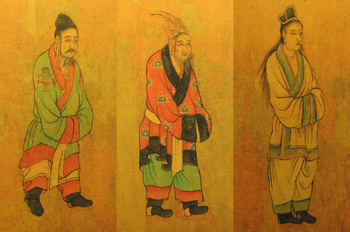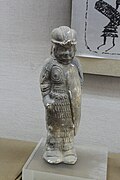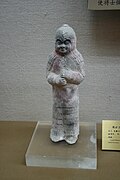Military history of the Sui dynasty

The military history of the Sui dynasty encompasses the period of Chinese military activity from 581 to 618. Although the Sui dynasty was relatively short lived, it set the precedent for the Tang dynasty that followed.
Organization
The
Equipment
The Sui dynasty made prodigious use of heavy cavalry and both men and horses were often heavily armoured.[1]
The Book of Sui provides an account of the "first cavalry battalions" of the dynasty's Twenty-four armies. They wore "bright-brilliant" (mingguang) armour made of decarburized steel connected by dark green cords, their horses wore iron armour with dark green tassels, and they were distinguished by lion banners. Other battalions were also distinguished by their own colors, patterns, and flags, but neither the bright-brilliant armour or iron armour are mentioned.[2][3]
-
Sui soldier
-
Sui soldier
-
Sui soldier
-
Sui soldier
-
Sui soldier
-
Sui pottery soldier
-
Sui cavalry
-
Sui swords
Campaigns and battles
Emperor Wen of Sui (581–604)


On 4 March 581, Yang Jian deposed Yuwen Chan, and declared himself Emperor of the Sui dynasty.[4]
1st Göktürks (582–585)
In 582, Ishbara Qaghan raided the Wei River valley and made off with large amounts of livestock.[5]
In 585, Ishbara Qaghan was defeated by Sui forces at the
Western Liang (587)
In 587, the Sui dynasty annexed Western Liang and began preparations for an invasion of the Chen dynasty.[4]
Chen dynasty (588–589)
War vessels were built in
By the late fall of 588, the Sui dynasty had marshaled three fleets and five armies along the
Chen commander
On 22 January 589, Sui commander
I met the armies that opposed me on the way to Jiankang and not only did I defeat them but I made prisoner one of the very distinguished and brave Chen commanders. It was really through me that the victory over Jiankang was gained, because of the courage of my men, the enemy was so terror struck that resistance was abandoned. And so your greatness rules the whole of the Great Realm.[9]
— Heruo Bi to Emperor Wen of Sui
The only commander to offer any significant resistance was the governor of Wu Commandery. He was defeated by a two pronged attack from overland by Yang Guang and oversea by Yan Rong.[8]
In late 590, a large rebellion occurred at Lake Tai in response to rumors that the Sui government was planning on relocating hundreds of thousands of northerners to the north. The rebellion spread south all the way to present-day Vietnam. However the rebel forces suffered several defeats to Yang Su and his commander Shi Wansui. The rebellion was eventually ended when Yang Su persuaded one of the two primary rebel leaders to turn on his colleague and hand him over to the Sui in return for his own life.[10]
Demobilization
On 16 June, 590, it was decreed that the Twenty-four Armies would be demobilized and registered under the Equal-field system.[11]
On 12 April 595, it was decreed that all weapons in the empire and any southern boat longer than 30 feet would be confiscated.[11]
Cuanman (593–602)
In 593, the Cuanman rebelled in Yunnan. A punitive expedition was launched in 597 and the Cuanman were defeated in 602.[12]
1st Goguryeo (598)


In early 598, Goguryeo and the Mohe people raided Sui territory. The Sui retaliated with a 300,000 strong army on 4 August. Due to torrential rains, food shortage, and sickness, the army withdrew in October. A waterborne invasion from Shandong encountered storms and lost many of its vessels.[13]
2nd Göktürks (599)
In 599, Tardu attacked the Sui dynasty but was defeated by Yang Su.[14]
Early Lý dynasty (602)
In 602, Sui forces under Liu Fang annexed the Kingdom of Vạn Xuân ruled by the Early Lý dynasty.[13]
Emperor Yang of Sui (604–618)
Champa (605)
In 605, Sui forces under Liu Fang invaded Champa. The Cham army fielded elephants against the Sui army. Liu Fang had his soldiers dug pits and covered them with grass. When the elephants blundered into them while chasing a feigned flight, the Sui forces turned around and shot the elephants with crossbows. The elephants stampeded into the Chams and routed their own army. Liu Fang went on to sack the Cham capital but died from disease on the way back.[13]
Tuyuhun (608)
In 608, Sui forces defeat the
2nd Goguryeo (612)

Emperor Yang of Sui began preparations for a campaign against Goguryeo in 610 when he imposed a new tax on wealthy families to purchase horses for his army. He officially announced the expedition on 14 April 611. Three hundred seagoing vessels were constructed in Donglai and 10,000 marines were transferred from the southern river systems to crew them. In addition to the regular forces, 30,000 javelin-men were recruited from Lingnan and 30,000 crossbowmen as well. On 1 June, the emperor arrived in Zhuo Commandery, south of modern Beijing. Connecting this location to the Huai River was the Yongji canal, which allowed the buildup of military materiel. Craftsmen in were ordered to construct 50,000 carts to transport clothing, armour, and tents. Some 600,000 men were mobilized to move wheelbarrows of grain northeast of Zhuo Commandery. According to the History of Sui, the combined 30 armies gathered for the expedition numbered 1,133,800 combat troops, and another two million serving in logistical capacity. David Graff gives a reduced estimate of 600,000 for the land forces and another 70,000 for the fleet.[16]
On 8 February 612, the vanguard began their march for Goguryeo. They reached the
The fortress of Ryotongseong had not fallen and the siege was taking too long, so Emperor Yang sent nine of the thirty armies ahead with 100 days' supply of grain. However, by the time they had reached the Yalu River, most of the provisions had been spent. Some of the soldiers stored the grain underground because they could not bare the burden. One of the army commanders, Yuwen Shu, suggested that they retreat, but Yu Zhongsheng, who was in overall command refused. Eventually they were forced to retreat due to lack of provisions, but as the nine armies were crossing the Sa River, a strong attack by Goguryeo inflicted immense casualties on the units remaining on the southern bank.[18]
Your brilliant plans expose reality.
Your subtle understandings encompass the world
You win all the battles; you are invincible.
Why not accept victory and end this war?[19]— Eulji Mundeok to Yu Zhongsheng
On 27 August, Emperor Yang received news of the defeat and called off the campaign.[18]
3rd Goguryeo (613)
On 28 January 613,
Yang Xuanguan (613)

On 25 June 613, Yang Xuangan rebelled in Liyang. He laid siege to Luoyang for several weeks before giving up and fleeing further west where he was killed by Sui forces.[21]
4th Goguryeo (614)
On 4 April 614, Emperor Yang of Sui ordered a new campaign against Goguryeo. The new army arrived on the Liao River on 27 August but failed to make any headway against the border fortresses. Lai Huer crossed the Bohai Sea and defeated a Goguryeo army. Yeongyang of Goguryeo sued for peace and Emperor Yang declared victory, withdrawing across the Liao.[21]
3rd Göktürks (615)
In the summer of 615, Emperor Yang of Sui was surrounded at Yanmen Commandery by Shibi Khan, but managed to escape after machinations at the Göktürk court caused them to retreat.[22]
Transition from Sui to Tang
After failing to defeat
- Dou Jiande, "King of Changle/Xia", who occupied central Hebei[23]
- Changjiang[24]
- Li Mi, "Duke of Wei", who occupied Henan[24]
- Liang Shidu, "Emperor of Liang", who occupied Shuofang Commandery[26]
- Liu Wuzhou, who occupied Mayi Commandery[26]
- Wang Shichong, who occupied Luoyang[24]
- Changjiang[24]
- Xue Ju, "Hegemon King of Western Qin", who occupied eastern Gansu[26]
References
- ^ Peers 2006, p. 115.
- ^ Graff 2002, p. 147.
- ^ Graff 2002, p. 158.
- ^ a b Xiong 2009, p. cvi.
- ^ a b Graff 2002, p. 143.
- ^ Graff 2002, p. 132.
- ^ a b Graff 2002, p. 133.
- ^ a b Graff 2002, p. 134.
- ^ Romane 2018, p. 23.
- ^ Graff 2002, p. 135.
- ^ a b Graff 2002, p. 139.
- ^ Yang 2008a.
- ^ a b c Graff 2002, p. 145.
- ^ Graff 2002, p. 144.
- ^ Twitchett 1979, p. 228.
- ^ Graff 2002, p. 148.
- ^ Graff 2002, p. 150.
- ^ a b Graff 2002, p. 151.
- ^ Romane 2018, p. 43.
- ^ Graff 2002, p. 153.
- ^ a b Graff 2002, p. 154.
- ^ Graff 2002, p. 155.
- ^ Graff 2002, p. 162.
- ^ a b c d Graff 2002, p. 163.
- ^ Graff 2002, p. 165.
- ^ a b c Graff 2002, p. 164.
Bibliography
- Graff, David A. (2002), Medieval Chinese Warfare, 300-900, Routledge
- Peers, C.J. (2006), Soldiers of the Dragon: Chinese Armies 1500 BC - AD 1840, Osprey Publishing Ltd
- Romane, Julian (2018), Rise of the Tang Dynasty
- Xiong, Victor Cunrui (2009), Historical Dictionary of Medieval China, United States of America: Scarecrow Press, Inc., ISBN 978-0810860537
- Yang, Bin (2008a), "Chapter 3: Military Campaigns against Yunnan: A Cross-Regional Analysis", Between Winds and Clouds: The Making of Yunnan (Second Century BCE to Twentieth Century CE), Columbia University Press
- Twitchett, Denis (1979), The Cambridge History of China 3-1








